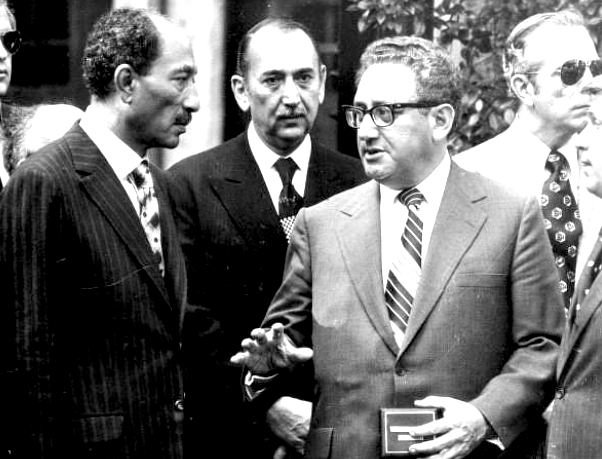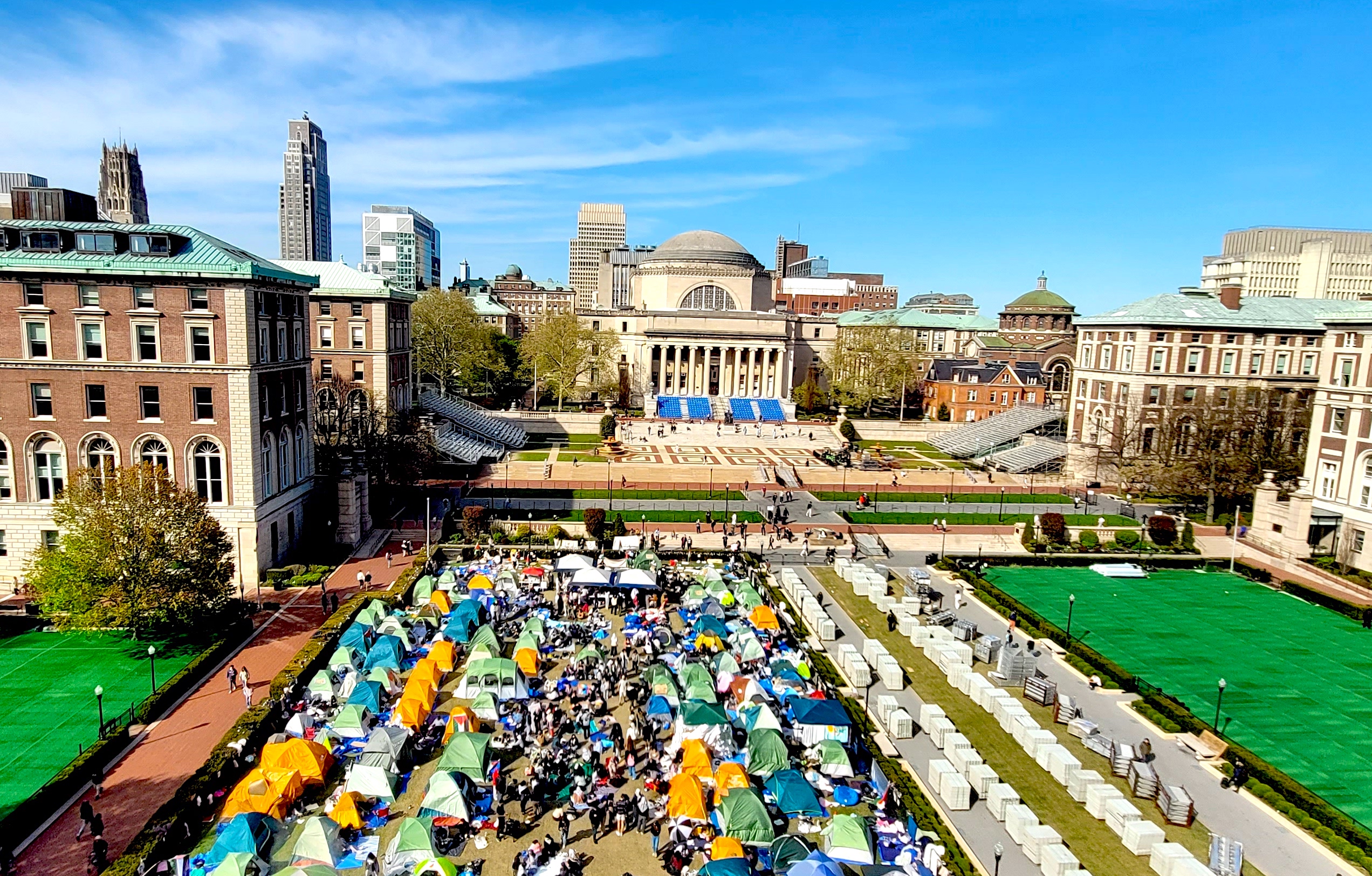While their ultimate impact should not be exaggerated, the protests for Palestine taking place on U.S. college campuses are historic.

National March on Washington to Free Palestine, Nov. 4, 2023. (Elvert Barnes, Wikimedia Commons, CC BY-SA 2.0)
By As`ad AbuKhalil
Special to Consortium News
 There is a long history of muted protests for Palestine on college campuses. Imagine, Palestine never drew the attention of the American left in the 1960s and 1970s. Few Americans knew the word Palestinian before the assassination by Palestinian American, Sirhan Sirhan.
There is a long history of muted protests for Palestine on college campuses. Imagine, Palestine never drew the attention of the American left in the 1960s and 1970s. Few Americans knew the word Palestinian before the assassination by Palestinian American, Sirhan Sirhan.
Most leaders of the American left (including Michael Harrington and Jerry Rubin) were staunch Zionists and thought of Israel as a progressive project in the midst of reactionary Arab countries (not that progressive Westerners were free of the racism that afflicted conservative Westerners).
The AFL-CIO and all affiliates of the Democratic Party were prominent elements of the Israel Lobby. It was a time when Republicans in New England were more likely to oppose Israel than liberal Democrats of the big cities.
College campuses were hostile to Palestinian activism and after 1975, Congress initiated legislation to conflate Palestinian struggle with terrorism. In the 1980s, a group of students in California faced deportation because they attended a “haflah” (literally, party) which was allegedly sponsored by the Popular Front for the Liberation of Palestine.
In 1984, the American Israel Public Affairs Committee published The AIPAC College Guide: Exposing the Anti-Israel Campaign on Campus which failed, in fact, to show much anti-Israeli presence on college campuses (with the exception of a few places such as Georgetown University).
Many U.S. universities (including Georgetown which was accused of pro-Arab bias) established chairs for visiting Israeli professors. There were and are more college courses offered on Israel than on all of Asia and Africa combined.
Israel fought the spread of knowledge about Arabs and Islam and the creation of the Center for Contemporary Arab Studies at Georgetown was met with enormous opposition and resistance from the Israel Lobby.
The reason leaders of the Lobby are freaking out now is because people, especially the young, are learning for the first time about Palestine and not through traditional media.
Washington’s effort to ban TikTok, which faces a legal challenge, is largely due to the propagation of information, not opinions, about the Arab-Israeli conflict.
Harassment & Frustration

Egyptian President Anwar Sadat, left, and U.S. National Security Advisor and Secretary of State Henry Kissinger in November 1973. (From the C.I.A. booklet “President Nixon and the Role of Intelligence in the 1973 Arab-Israeli War,” CIA/Flickr/U.S. government)
Arab students in the U.S. were active on Palestine in the 1960s and 1970s, but those were the days of J. Edgar Hoover’s F.B.I. Arabs were closely monitored and harassed and were often deported for political involvement in civil rights protests.
The Black power movement, especially the Black Panthers, shifted the discourse on Palestine, as far as the left was concerned. The so-called New Left, in Germany and in the U.S., did not really advocate against Israeli occupation and aggression.
The remarks about Palestine by the German social critic Herbert Marcuse were rather careful (although his widow told me that he was planning to speak more about Palestine in his last years).
The Black Panthers established direct ties with the PLO’s guerrilla movement, and some joined their training camps.
Activist Arabs were part of the Arab student union, which focused attention on the one issue that captivated the imagination of Arabs, namely the Palestinian cause. Arab organization was at the pan-Arab level and Arab students were not split into various narrow nationalist groups (like Syrian or Lebanese etc).
Activism in the U.S. at the time was marred by many factors that frustrated Arabs’ efforts: 1) Arab-American organizations were very weak and were largely dominated by Republican Lebanese business community, which did not wish to offend any U.S. administration.
There was a disconnect between the leadership of Arab-American organizations like the National Association of Arab Americans and grassroots Arab students in the U.S.
Please Donate to the
Spring Fund Drive!
Before 1975 the U.S. did not prohibit any PLO organization on U.S. soil. The PLO was founded in 1964 and the U.S. government regarded it with sinister neglect. They didn’t think Arab military forces would amount to anything and Israel at the time thought it could handle the threat.
Israeli and American concerns were focused on Arab governments and armies that were ostensibly trying to liberate Palestine. The bête noire of that era was Egypt’s President Gamal Abdel Nasser, at a time when Iran was led by a pro-U.S., pro-Israel despot.
Arabs and Palestinians in the U.S. chose among various PLO groups. Their menu was rich: from conservative organizations such as Fatah, to Marxist Leninist groups like the organizations the Popular Front for the Liberation of Palestine (PFLP), and the Democratic Front for the Liberation of Palestine (DFLP).
Until the 1970s, Arab students in the United States formed part of the landscape of organizing for Palestine. But then, in the 1970s, PLO leader Yasser Arafat assigned none other than Mahmoud Abbas to take over management of Palestinian student activities in the U.S.
According to Palestinian author and historian Elias Shoufani’s memoirs, Arafat and Abbas decreed that Palestinian organizations and activism would be split from Arab student activism. That decision deprived the Palestinian movement of a large supply of Arab supporters.
Something similar was occurring back in the Middle East where Arafat emphasized the separateness of the Palestinian national movement (he raised the slogan “independent Palestinian decision making” while subservient to Saudi Arabia). That isolated the movement when it was attacked in Jordan, Lebanon and the rest of the Arab world.
Reconfiguration in 1967

Gaza solidarity encampment at Columbia University in New York on April 23. (Abbad Diraniya, Wikimedia Commons, CC0)
Arab-American professors weren’t organized and couldn’t guide Arab students desperate to advocate for Palestine. It was the 1967 defeat to Israel that reconfigured Arab-American organizations and the founding that year of the Association of Arab-American University Graduates (AAUG).
The AAUG quickly drew students from around the United states to attend its annual convention and conferences to hear professors speak on various aspects of the Palestinian question. The organization served as a bridge between politics back home and activism by Arab students in the U.S.
AAUG conference organizers invited professors and political leaders from the Arab world — provided they weren’t on a ban list due to communist affiliation. (Lebanese Communist leader Fawwaz Trabulsi, for instance, was banned for many years from entering the U.S.)
A New Era
Clearly there’s been a change in college student protests regarding Palestine. In the last two decades there’s been regular, though not frequent, commemoration of Palestinian historical moments and tragedies, such as the Nakba.
Many student clubs (notably Students for Justice in Palestine, or SJP) — especially in the U.S., U.K. and Canada —hold weeks to focus attention on Israeli apartheid, educating the public about the savagery of the Israeli occupation and aggression.
I spoke at several of those events in the U.K., Canada and the U.S. in the last two decades and what struck me was how membership in those clubs was expanding. Activists for Palestine succeeded through intersectionality — the connection of causes — in building bridges and making connections with other progressive movements and anti-racist organizations.
Those links have in particular paid off during this war. We’ve seen how ready those clubs were to respond to the unprecedented Israeli genocide in Gaza. Activism isn’t confined, as it was in the past, to Arabs and Arab Americans.
The new movement comprises people from different races, backgrounds, ethnicities and religions. Progressive Jews are part of all the college clubs that advocate for Palestine.
This broadened the appeal of the movement and several SJP clubs were led by African Americans or Jewish Americans as well as Arab Americans.

Participants in a 22-mile, interfaith global pilgrimage to bring peace to Gaza on March 23 in Oakland, California. (Peg Hunter, Flickr, CC BY-NC 2.0)
A second factor helped to rejuvenate and empower activism on Palestine in recent years. The new leaders of Arab Americans on college campuses haven’t been males obsessed with business careers in the West or in the Gulf. The new leaders are largely Palestinian- American women who are radical, uncompromising and fierce.
The older generation of male leaders were more prone to compromise were easier for the Zionist establishment to intimidate.
Palestinian-American women organized the historic “National March on Washington, Free Palestine” in Washington in November. Over 300,000 marched under the banner of Palestine liberation, something people had never dared undertake in America before.
This movement on college campuses is historic: for the first time a foreign policy issue that has no direct domestic links (other than tax money for genocide) is at stake (the Vietnam protest movement was also domestic, because students were fighting to avoid dying in war).
Young Americans are now more educated about Palestine thanks to the student movement. But the impact of the students’ protests should not be exaggerated, not only because the leadership of both parties remain solidly pro-Israel, but also because young people don’t vote in large numbers and when they do vote, only two percent rank foreign policy as determining their vote.
As`ad AbuKhalil is a Lebanese-American professor of political science at California State University, Stanislaus. He is the author of the Historical Dictionary of Lebanon (1998), Bin Laden, Islam and America’s New War on Terrorism (2002), The Battle for Saudi Arabia (2004) and ran the popular The Angry Arab blog. He tweets as @asadabukhalil
The views expressed are solely those of the author and may or may not reflect those of Consortium News.
Please Donate to the
Spring Fund Drive!


